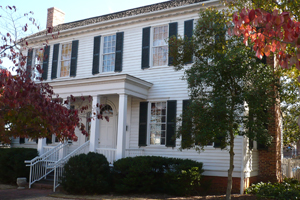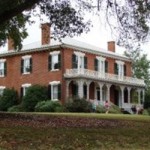ATHENS HOUSE MUSEUMS
Athens House Museums
Athens boasts four house museums dated from the early to mid-nineteenth century: The Church-Waddel-Brumby House, the Lyndon-Ware House, the Taylor Grady House, and the T.R.R. Cobb House. All located within a mile from the University campus, they provide important historic resources for MHP students.
Church-Waddel-Brumby House
280 E Dougherty St (1820) – This house, built by UGA professor Alonzo Church, is believed
to be the oldest surviving residence in Athens. Moses Waddel was the home’s first
resident, residing in the home during his tenure as the University President. After
Sarah  Harris purchased it in 1834 and left it to her granddaughters Mary Harris Brumby and
Anne Wallis Brumby, it remained within the same family until the 1960s. Saved from
demolition by local citizens and the fledgling Athens-Clarke Heritage Foundation in
1967, the residence was moved to its current location during the madness of a UGA
home football game and has served as the city’s Welcome Center since 1973. 2005 marked
the beginning of an ongoing interior restoration project by the ACHF, aimed at returning
the house to its former Federal style grandeur when University of Georgia President
Moses Waddel lived in the home. http://www.athenswelcomecenter.com/.
Harris purchased it in 1834 and left it to her granddaughters Mary Harris Brumby and
Anne Wallis Brumby, it remained within the same family until the 1960s. Saved from
demolition by local citizens and the fledgling Athens-Clarke Heritage Foundation in
1967, the residence was moved to its current location during the madness of a UGA
home football game and has served as the city’s Welcome Center since 1973. 2005 marked
the beginning of an ongoing interior restoration project by the ACHF, aimed at returning
the house to its former Federal style grandeur when University of Georgia President
Moses Waddel lived in the home. http://www.athenswelcomecenter.com/.
Taylor Grady House
 634 Prince Avenue (ca. 1844) – The Taylor Grady House was originally built around
1844 by General Robert Taylor and his wife when they moved to Athens as their sons
attended the University of Georgia. Around 1866, Henry W. Grady moved into the home
with his mother during his time at the University. During the 1950s and 1960s, the
house stood empty and became subject to vandalism until 1966 when it was bought by
the Athens Junior Assembly, who work to preserve the home. The house is now open to
both self-guided and guided group tours. http://www.taylorgradyhouse.com/.
634 Prince Avenue (ca. 1844) – The Taylor Grady House was originally built around
1844 by General Robert Taylor and his wife when they moved to Athens as their sons
attended the University of Georgia. Around 1866, Henry W. Grady moved into the home
with his mother during his time at the University. During the 1950s and 1960s, the
house stood empty and became subject to vandalism until 1966 when it was bought by
the Athens Junior Assembly, who work to preserve the home. The house is now open to
both self-guided and guided group tours. http://www.taylorgradyhouse.com/.
T.R.R. Cobb House
 175 Hill St (1834, 1852) — Originally built as Plantation Plain house in the 1830s,
Cobb received this house as a wedding gift in 1844 and added the Octagon style wings
and the Greek Revival portico in the 1850s. From the 1870s to the 1980s, it served
as everything from a rental/boarding house to a fraternity house to meeting space
for the Catholic Archdiocese of Atlanta. Facing demolition in 1985, it was moved to Stone Mountain,
GA to be part of Stone Mountain Park; however, restoration never commenced. But thanks
to the efforts of Athens preservationists (spearheaded by John Waters and the Athens-Clarke
Heritage Foundation), the Watson-Brown Foundation and the Georgia Trust for Historic
Preservation, the house was moved back to Athens in 2005 and opened as the Athens
newest house museum 2007. The T.R.R Cobb house provides changing exhibits and educational
opportunities with field trip programs. In addition, the house museum maintains a
Resource Room containing sources on the Civil War era in Georgia, Southern Decorative
Arts, and Victorian Architecture and Culture. www.trrcobbhouse.org/.
175 Hill St (1834, 1852) — Originally built as Plantation Plain house in the 1830s,
Cobb received this house as a wedding gift in 1844 and added the Octagon style wings
and the Greek Revival portico in the 1850s. From the 1870s to the 1980s, it served
as everything from a rental/boarding house to a fraternity house to meeting space
for the Catholic Archdiocese of Atlanta. Facing demolition in 1985, it was moved to Stone Mountain,
GA to be part of Stone Mountain Park; however, restoration never commenced. But thanks
to the efforts of Athens preservationists (spearheaded by John Waters and the Athens-Clarke
Heritage Foundation), the Watson-Brown Foundation and the Georgia Trust for Historic
Preservation, the house was moved back to Athens in 2005 and opened as the Athens
newest house museum 2007. The T.R.R Cobb house provides changing exhibits and educational
opportunities with field trip programs. In addition, the house museum maintains a
Resource Room containing sources on the Civil War era in Georgia, Southern Decorative
Arts, and Victorian Architecture and Culture. www.trrcobbhouse.org/.
Ware-Lyndon House
 293 Hoyt St. (ca 1840) – Edward R. Ware, an Athens physician and later the first mayor
of Athens, built the Ware-Lyndon House around 1840. The Greek Revival home, which
also features added Italianate and Victorian influences, was sold to Edward S. Lyndon
around 1880. Shortly after Lyndon’s death in 1917, the family moved from Athens and
the home became a rental property until 1938. The City of Athens purchased the house,
which has since been used for government offices and recreational uses. Following
its restoration in the 1960s, the house achieved listing on the National Register
of Historic Places in 1976. Beginning in the 1970s, the Lyndon House Art Center operated
in the home to provide art exhibits and classes, however moved to an on-site expanded
addition in the 1990s. The house museum today, furnished with period art and furniture,
is the last remaining testament to the historic Lickskillet neighborhood of 19th century Athens. http://www.athensclarkecounty.com/Facilities/Facility/Details/29.
293 Hoyt St. (ca 1840) – Edward R. Ware, an Athens physician and later the first mayor
of Athens, built the Ware-Lyndon House around 1840. The Greek Revival home, which
also features added Italianate and Victorian influences, was sold to Edward S. Lyndon
around 1880. Shortly after Lyndon’s death in 1917, the family moved from Athens and
the home became a rental property until 1938. The City of Athens purchased the house,
which has since been used for government offices and recreational uses. Following
its restoration in the 1960s, the house achieved listing on the National Register
of Historic Places in 1976. Beginning in the 1970s, the Lyndon House Art Center operated
in the home to provide art exhibits and classes, however moved to an on-site expanded
addition in the 1990s. The house museum today, furnished with period art and furniture,
is the last remaining testament to the historic Lickskillet neighborhood of 19th century Athens. http://www.athensclarkecounty.com/Facilities/Facility/Details/29.
Shields-Ethridge Heritage Farm
The Shields-Ethridge Heritage Farm is located in Jefferson, Georgia. Since 1799, this farm has remained agriculturally productive. Over the course of the two centuries, the Shields and Ethridge families adapted to larger trends in upcountry Georgia agriculture, from the first crops of tobacco to the planting of cotton and grains, and then cattle grazing. From about 1899 to 1909 Ira Washington Ethridge constructed these buildings, transforming the farm into a bustling center of social and economic activity in Jackson County, Georgia. Today the farm complex is quiet and open for your exploration. For more information visit: http://shieldsethridgefarminc.com/.
Jackson Street Cemetery
The cemetery, on Jackson Street on the University of Georgia’s North Campus, was used primarily between 1810 and 1856. When this 2.5 acre site was full Oconee Hill Cemetery (located behind Sanford Stadium) opened. There are approximately 800 graves, including those for merchants, tailors, ministers, children of UGA faculty members, and two UGA presidents, Robert Finley and Moses Waddel. The cemetery was added to the National Register of Historic Places in October, 2009. The cemetery has been cleaned up and repaired during a multi-year restoration process between 2007 and 2009. Vegetation has been cleared away, head stones have been repaired and cemetery monuments, including obelisks and vaults have received structural repairs.
